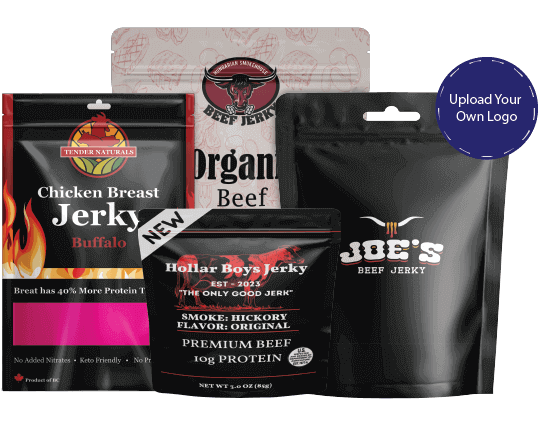Beef jerky has become a popular snack choice for many consumers seeking convenient, protein-packed options. As the market for beef jerky continues to grow, the packaging used to present and protect this product plays a crucial role in its success. Here are some key considerations and current trends in Packaging For Beef Jerky:
1. Material Selection
Choosing the right materials is essential for preserving the quality and flavor of beef jerky. Common packaging materials include:
- Resealable Pouches: These flexible pouches often made of multilayer films are popular for their convenience and ability to keep jerky fresh after opening.
- Vacuum-Sealed Packaging: This method removes air to extend shelf life, making it an ideal choice for jerky, which can spoil quickly if exposed to oxygen.
- Eco-Friendly Options: With the rise of sustainability concerns, brands are exploring biodegradable or recyclable materials to attract environmentally conscious consumers.
2. Design and Branding
The packaging design is critical for attracting consumers on the shelf. Key design elements include:
- Visual Appeal: Bold colors, appetizing imagery, and clear branding help grab attention and convey the product’s quality.
- Transparency Windows: Including a clear section on the packaging allows consumers to see the product, reinforcing quality and freshness.
- Informative Labels: Clear nutritional information, ingredient lists, and sourcing details can help build trust and inform health-conscious buyers.
3. Portion Control
As consumers seek healthy snacks, packaging that offers portion control can be appealing. Single-serving packs or smaller resealable bags can cater to on-the-go consumers and encourage responsible snacking.
4. Tamper-Proof Features
Safety and security are paramount in food packaging. Incorporating tamper-evident seals helps assure consumers that the product has not been compromised, enhancing brand integrity.
5. Innovative Packaging Solutions
To stand out in a crowded market, brands are adopting unique packaging solutions, such as:
- Interactive Packaging: QR codes or augmented reality features can engage consumers, providing additional information or promotions through their smartphones.
- Multi-pack Options: Offering bundles or multi-packs can cater to families or groups, encouraging bulk purchases.
6. Regulatory Compliance
Lastly, ensuring compliance with food safety regulations is vital. Packaging must include necessary information such as expiration dates, nutritional facts, and allergen warnings to meet consumer expectations and legal requirements.
Effective packaging for beef jerky is a blend of functionality, aesthetics, and compliance. As consumer preferences evolve, brands that prioritize quality materials, innovative designs, and sustainable practices are likely to thrive in the competitive landscape of the beef jerky market. Investing in thoughtful packaging can not only protect the product but also enhance brand loyalty and drive sales.
Advanced Insights on Packaging for Beef Jerky
7. Sustainability Trends
As consumers increasingly prioritize sustainability, brands are responding by adopting eco-friendly packaging solutions. Consider these strategies:
- Recyclable Materials: Brands are transitioning to materials that can be easily recycled, which helps minimize environmental impact.
- Reduced Packaging Size: Using less material without compromising product integrity can lower costs and appeal to eco-conscious consumers.
- Biodegradable Options: Some companies are experimenting with biodegradable packaging that breaks down more easily in landfills, contributing to a circular economy.
8. Shelf Life and Freshness
Maintaining freshness is crucial for meat snacks. Packaging innovations that extend shelf life include:
- Oxygen Absorbers: Incorporating oxygen scavengers within packaging helps prevent oxidation, preserving flavor and texture.
- Modified Atmosphere Packaging (MAP): This technique replaces the air in the packaging with a gas mixture that extends freshness by slowing down the growth of bacteria and molds.
9. Market Segmentation and Customization
Understanding different consumer segments allows brands to tailor their packaging strategies:
- Health-Conscious Consumers: Clear labels highlighting high protein, low sugar, and natural ingredients can attract this demographic. Consider using packaging that showcases these attributes prominently.
- Adventure and Outdoor Enthusiasts: Packaging designed for rugged use—like resealable, durable bags—can appeal to hikers and campers.
- Gift and Gourmet Markets: Premium packaging, such as gift boxes or decorative tins, can attract consumers looking for unique gifts or gourmet treats.
10. Challenges in Beef Jerky Packaging
While there are many opportunities, brands also face challenges:
- Cost Management: High-quality packaging materials can increase costs. Brands must balance quality and affordability while maintaining competitive pricing.
- Regulatory Compliance: Adhering to food safety regulations can be complex, requiring ongoing attention to ensure all packaging materials are approved for food contact and that labeling is accurate.
- Supply Chain Issues: Sourcing sustainable or innovative packaging can be challenging, especially in a fluctuating market where availability may vary.
11. Marketing Strategies through Packaging
Packaging is a vital marketing tool. Here are some strategies:
- Storytelling: Use packaging to tell the brand’s story, highlighting sourcing practices, company values, or the unique process that sets your jerky apart.
- Limited Editions: Seasonal flavors or limited-edition packaging designs can create a sense of urgency and exclusivity, encouraging consumers to try new products.
- Promotions and Loyalty Programs: QR codes that link to loyalty programs or promotional campaigns can incentivize repeat purchases and foster brand loyalty.
12. Consumer Education
Educating consumers about the product and packaging is essential:
- Nutritional Information: Clear and concise nutritional information helps consumers make informed choices.
- Storage Instructions: Providing guidance on how to store jerky properly after opening can enhance freshness and reduce waste.
The packaging of beef jerky is more than just a protective shell; it serves as a crucial element in branding, marketing, and consumer engagement. By staying ahead of trends and addressing challenges, brands can create effective packaging solutions that resonate with consumers and enhance their overall experience. The right packaging not only protects the product but also reflects the brand’s values and commitment to quality, sustainability, and consumer satisfaction.
In-Depth Exploration of Beef Jerky Packaging
13. Innovative Technologies in Packaging
Technological advancements are shaping the future of beef jerky packaging, offering enhanced protection, convenience, and sustainability. Here are some notable innovations:
- Smart Packaging: Incorporating sensors or indicators that change color when the product is no longer fresh can inform consumers about the state of the jerky. This technology helps maintain quality and safety.
- Active Packaging: Packaging that actively interacts with the contents, such as moisture control or antimicrobial agents, can help extend shelf life and preserve flavor.
- Edible Packaging: Though still in the experimental stage, edible films made from natural materials offer a unique solution that could reduce waste and enhance convenience.
14. Packaging Size Variability
Offering a variety of packaging sizes can cater to different consumer needs:
- Family Packs: Larger, value-oriented packs for families or gatherings can boost sales and encourage bulk buying.
- Single-Serve Packs: Ideal for on-the-go snacking, single-serve packs can attract busy consumers or those looking for healthy snack options.
- Snack Sizes: Smaller, more affordable packs can encourage trial purchases and allow consumers to sample different flavors without committing to larger sizes.
15. Trends in Flavor Packaging
As beef jerky evolves, flavor innovation is essential. Packaging can reflect this trend:
- Flavor Profiles on Packaging: Highlighting unique flavors or limited-edition varieties prominently on the packaging can entice consumers. Using vibrant graphics or thematic designs can enhance appeal.
- Flavor Pairing Suggestions: Including suggestions for pairing jerky with beverages or other snacks on the packaging can inspire consumers and promote cross-selling opportunities.
16. Cultural and Regional Influences
Regional preferences can influence packaging designs:
- Cultural Aesthetics: Brands can incorporate cultural symbols, colors, and patterns that resonate with local consumers, enhancing relatability and marketability.
- Local Sourcing Claims: Highlighting local ingredients or production methods can attract consumers interested in supporting local businesses and sustainability.
17. Consumer Engagement through Packaging
Engaging consumers through packaging can foster brand loyalty and repeat purchases:
- Interactive Elements: Incorporating games or contests on the packaging can engage consumers and encourage social media sharing. For example, a QR code leading to a contest or survey can enhance consumer interaction.
- Personalization: Brands can offer customizable packaging options where consumers can add names or messages, making the product more personal and memorable.
18. Case Studies of Successful Beef Jerky Brands
Examining successful brands can provide insights into effective packaging strategies:
- Jack Link’s: Known for its bold branding and vibrant packaging, Jack Link’s uses clear labeling to highlight its protein content and flavor variety. The brand frequently updates its packaging to reflect current trends, such as sustainable materials and eye-catching graphics.
- Krave Jerky: This brand focuses on a premium experience with sophisticated packaging that emphasizes gourmet flavors. Their use of transparent windows and sleek designs appeals to health-conscious consumers looking for high-quality snacks.
- Wild Bill’s: This brand utilizes nostalgic and rugged packaging that reflects its outdoor and adventurous brand image. The packaging often features Western themes and illustrations, appealing to consumers looking for authenticity and adventure.
19. Market Research and Consumer Feedback
Conducting market research can help brands understand consumer preferences regarding packaging. Techniques include:
- Surveys and Focus Groups: Gathering feedback on packaging designs, materials, and features can guide future decisions.
- Sales Data Analysis: Analyzing which packaging formats and sizes perform best in different retail environments can inform strategic changes.
The packaging of beef jerky is a multifaceted aspect that significantly impacts consumer perception, sales, and brand loyalty. By leveraging innovative technologies, catering to diverse consumer preferences, and drawing inspiration from successful brands, companies can create packaging that not only protects the product but also enhances the overall consumer experience. Our team collaborated with a Vancouver Packaging firm to develop sustainable and visually appealing solutions for our new product line. As the market evolves, staying attuned to trends and continuously seeking feedback will be vital for success in the competitive beef jerky landscape.



